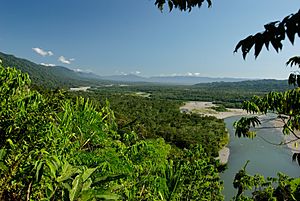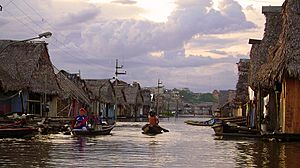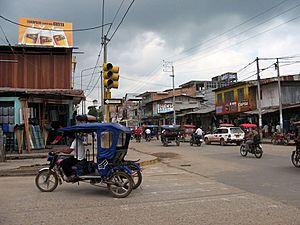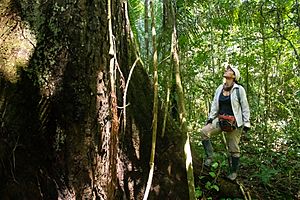Peruvian Amazonia facts for kids
The Peruvian Amazonia (which means "Amazon of Peru" in Spanish) is also known as the Peruvian jungle or simply the jungle. It's the part of the Amazon rainforest that is inside Peru. This huge area stretches from the east side of the Andes mountains all the way to the borders with Ecuador, Colombia, Brazil, and Bolivia. It covers about 60% of Peru and is full of amazing plants and animals. Peru has the second-largest part of the Amazon rainforest, right after Brazil.
Contents
How Big is the Peruvian Amazon?
Most of Peru's land is covered by thick forests on the eastern side of the Andes. Even though it's a huge area, only about 5% of Peru's people live there. More than 60% of Peru's land is covered by the Amazon rainforest, which is more than in any other country.
Experts from the Research Institute of the Peruvian Amazon (IIAP) have measured the area in two ways:
- Based on nature: It covers about 782,880 square kilometers. This is about 60.91% of Peru's total land and around 11.05% of the entire Amazon jungle.
- Based on rivers: It covers about 96,922 square kilometers. This is about 75.31% of Peru's land and around 16.13% of the whole Amazon river basin.
Nature Areas and Weather

The Peruvian Amazon is usually divided into two main natural areas:
Lowland Jungle
This area is also called the Selva Baja or Omagua region. It's the biggest natural area in Peru, sitting between 80 and 1,000 meters above sea level. The weather here is very warm, with an average temperature of 28 °C. It's also very humid (over 75% humidity) and gets about 260 cm of rain each year. The soils are different in different places, but most come from rivers. Because of the heat and heavy rain, the soils don't have many nutrients.
Many long and powerful rivers flow through the lowland jungle. These include the Apurimac, Mantaro, Amazon, Urubamba, Ucayali, Huallaga, Marañón, Putumayo, Yavarí, Napo, Pastaza, Madre de Dios, Manu, Purus, and Tigre. The Apurimac River is actually where the mighty Amazon River begins! Important nature reserves like the Pacaya-Samiria National Reserve are found here.
Highland Jungle
This area is called the Selva Alta or Rupa-Rupa region. It stretches along the eastern slopes of the Andes mountains, from 1,000 to 3,800 m above sea level. These mountain slopes are home to a huge variety of animals and plants. This is because there are many different heights and climates in this region. Temperatures are warm at lower parts and get cooler as you go higher. Many unique animals live here that are found nowhere else. This is due to the mountains keeping them isolated.
All parts of the Amazon rainforest have one thing in common: lots of rain. Over a year, a tropical forest can get between 1,500 and 3,000 mm of rain. This creates the typical rainforest atmosphere, with an average temperature of around 24 °C or more.
Amazing Biodiversity
The Peruvian Amazon jungle is one of the most diverse places on Earth when it comes to living things. Peru has the most bird species in the world. It also has the third-largest number of mammals. About 44% of all bird species and 63% of all mammal species in Peru live in the Amazon. Peru also has a very high number of butterflies, orchids, and many other creatures.
| Type of Animal/Plant | Number of Known Species | Percentage of Species | |||
|---|---|---|---|---|---|
| In the World | In Peru | In the Peruvian Amazon | Peru vs. World | Peruvian Amazon vs. Peru | |
| Amphibians | 5,125 | 403 | 262 | 8 | 65 |
| Birds | 9,672 | 1,815 | 806 | 19 | 44 |
| Flowering plants | 250,000 | 17,144 | 7,372 | 7 | 43 |
| Ferns | 10,000 | 1,000 | 700 | 10 | 70 |
| Mammals | 4,629 | 462 | 293 | 10 | 63 |
| Butterflies | 16,000 | 3,366 | 2,500 | 21 | 74 |
| Fish (river fish) | 8,411 | 900 | 697 | 11 | 77 |
| Reptiles | 7,855 | 395 | 180 | 5 | 46 |
People of the Amazon


Even though the Peruvian Amazon is the largest region in Peru, it has the fewest people. Only about 5% of Peru's population lives here. Many indigenous peoples, like the Aguaruna and Urarina, call the jungle home. Some of these groups live in relative isolation from the rest of the world.
Here are some of the main cities in the Peruvian Amazon:
- Lowland Jungle Cities:
- Iquitos with 500,000 people at 104 m high (in the Loreto Region)
- Pucallpa, with 380,000 people at 154 m high (in the Ucayali Region)
- Yurimaguas with 140,000 people at 182 m high (in the Loreto Region)
- Puerto Maldonado with 104,000 people at 139 m high (in the Madre de Dios Region)
- Highland Jungle Cities:
- Tarapoto with 181,000 people at 350 m high (in the San Martin Region)
- Jaén with 86,743 people at 729 m high (in the Cajamarca Region)
- Moyobamba with 77,000 people at 860 m high (in the San Martin Region)
- Bagua with 65,000 people at 400 m high (in the Amazonas Region)
- Rioja with 60,000 people at 848 m high (in the San Martin Region)
Challenges in the Amazon
The Peruvian Amazon faces several big challenges, mainly from human activities.
Illegal Logging
In recent years, cutting down trees illegally has become a serious problem in the Peruvian Amazon. The World Bank estimated in 2012 that 80% of Peru's wood exports were harvested illegally. This uncontrolled cutting down of trees can harm the homes of indigenous tribes and reduce Peru's amazing biodiversity. It also adds to climate change. Sometimes, people who speak out against illegal logging have lost their lives. For example, in 2014, four indigenous leaders, including environmental activist Edwin Chota, were killed after asking for government protection.
The Peruvian government tried to help local people by giving them permits for small-scale logging. However, large logging companies started using these permits to create a huge, illegal logging industry. Even though laws were changed to improve the logging sector, the problem continued. This is partly because other countries, like Brazil, banned the export of valuable wood like mahogany, which made illegal logging in Peru more profitable.
It's hard to stop illegal logging in the vast Amazon. However, exporting the wood should be easier to control. Yet, companies have found ways to ship illegal timber out of the country. They often get permits for wood that doesn't really exist, and then use these permits to transport both legal and illegal wood. It's very difficult for authorities to check every shipment.
Illegal Gold Mining
Illegal gold mining is a big problem in the Madre de Dios Region of Peru. It causes a lot of harm to the environment. More people are mining gold because its price has gone up a lot in the last ten years. This makes it very tempting for people who need jobs. It's thought that about 30,000 miners are working without legal permits.
Miners use mercury to collect gold particles. Then, they burn off the mercury, often without proper safety. This releases mercury into the air and water, which pollutes the environment. This pollution directly affects people, animals, and plants in the area and beyond. The harmful effects of gold mining in Madre de Dios are so severe that they can even be seen from space.
Illegal Oil Extraction
Getting oil from the ground is another major threat to the health of the Peruvian Amazon. While the land might have a lot of oil, many indigenous people live in these rainforest areas. Projects like the Camisea Gas Project affect the daily lives of these local communities. Even though these projects can bring economic benefits, like saving money on energy, they also cause widespread environmental and cultural damage.
Oil and gas extraction often leads to the building of new roads. These roads then make it easier for other illegal activities, like logging and gold mining, to happen. The area where the Camisea project is located is very important for its biodiversity and conservation. Oil extraction projects can lead to fewer fish, more deforestation, pollution, and even disease for indigenous people. Experts say the government has limited power to stop these oil activities, and there are many loopholes in the laws, making it very hard to control.
See also
- 2009 Peruvian political crisis
- List of Peruvian monkey species
 In Spanish: Amazonía del Perú para niños
In Spanish: Amazonía del Perú para niños



